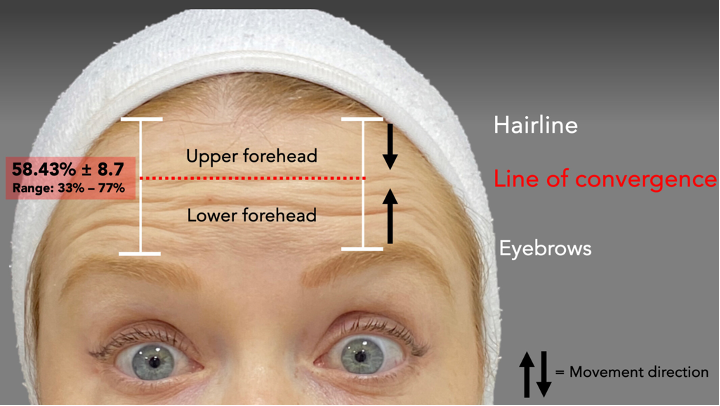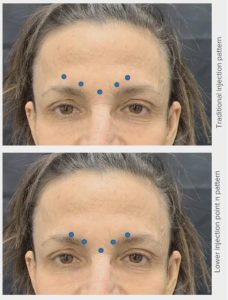At the 2025 ODAC Dermatology Conference in Orlando, Dr. Jacqueline Watchmaker, a Fellowship-trained cosmetic dermatologist practicing at Southwest Skin Specialists in Scottsdale, Arizona, shared valuable insights on assessing and managing neuromodulator complications.
“Heavy Eyelids” Following Neuromodulator Injections in the Forehead
When addressing heavy eyelids, Dr. Watchmaker stated that it’s crucial to first determine whether the issue lies with the brow or the eyelid itself.
Brow Ptosis: Causes and Solutions
1) Too Many Units Overall in Frontalis
Solution: Decrease the number of units in the forehead. Start with less units and offer patients a follow up appointment after 2 weeks to reassess and add more neurotoxin if needed.
2) Too Many Units Too Low or Lateral in the Frontalis
Solution: Consider placing more units above the line of convergence. This anatomical feature marks the bidirectional movement of the frontalis muscle, where the lower frontalis (responsible for upward movement) meets the upper frontalis (controlling downward movement).

Image detailing the line of convergence and where to inject to decrease brow drop. Meneses et al. (2024) – Increasing precision during neuromodulator injections for frontal rhytids: Using ultrasound imaging to identify the line of convergence. Journal of Cosmetic Dermatology, 23(7), 2373-2379. doi: 10.1111/jocd.16368.
Dr. Watchmaker also educated on patients who have what she refers to as “commas” or “little rainbows” above their lateral brow. She cautioned to avoid injecting these lines initially, especially if these patients have low eyebrows and instead focusing on lifting the brow by injecting the high frontalis and glabella. Reassess after 2-3 weeks, and if needed, inject superficially (intradermally). Injection depth affects neurotoxin intensity: deep frontalis injections are best for pronounced effects and persistent wrinkles, while superficial injections are better for subtle smoothing and minimizing frontalis impact and eyebrow droop risk.
3) Diffusion of Neuromodulator from Glabellar Complex to Lower Frontalis
Solution: To minimize diffusion, consider dropping your glabellar injection points lower. Refer to the image below for guidance.

Image showing where to inject for the modified glabellar injection technique. Photograph was provided courtesy of Dr. Jacqueline Watchmaker
Another solution is to use a higher concentration of neuromodulator in the glabella (10u/0.1cc). Dr. Watchmaker noted that if you’re concerned about diffusion into the frontalis when injecting the corrugators, keep in mind that more diluent leads to greater diffusion, while less diluent results in less diffusion.
How to Improve Brow Ptosis
Dr. Watchmaker suggested adding units to the depressor muscles (procerus/corrugators/orbicularis oculi) to help lift the brow. She also emphasized that, with time, the neurotoxin’s effects will naturally fade, resolving the brow ptosis withouot intervention.
In addition, Dr. Watchmaker discussed that weekly bacteriostatic saline (BS) injections may offer a solution. She cited a recent study by Rullan et al., which found that 86% of patients experienced improvement within 1-2 weeks following a single set of injections with 1mL of bacteriostatic saline on the side with the brow droop.
True Eyelid Ptosis
True eyelid ptosis occurs when neurotoxins bind to receptors on the levator palpebrae superioris (LPS) muscle. This can happen in a couple of ways:
-
- Diffusion through the orbital septum: This is more likely if the anatomy has been disrupted by previous eyelid surgery.
- Diffusion through the supraorbital foramen: The neurotoxin can travel along the neurovascular bundle.
It’s worth noting that some patients have a notch instead of a foramen on the inner surface of their orbital rim. The foramen provides a direct route to the LPS muscle, while the notch would require the toxin to diffuse over a greater distance, making ptosis less likely.
How to Prevent Eyelid Ptosis
-
- Use low-volume, highly concentrated neurotoxin injections for the lateral corrugator
- Administer low-volume injections in the glabella
- Inquire about previous eyelid surgeries (which may result in a weakened/incomplete orbital septum or baseline weakness of levator muscles)
- Instruct patients to avoid massaging the area for 1-2 hours post-injection
- While injecting the corrugator supercilii, apply digital pressure over the supraorbital rim with your non-injecting hand
How to Improve Eyelid Ptosis
-
- Oxymetazoline HCL 0.1% drops: Apply 1 drop per eye once daily (effects last 6-8 hours). This is the only FDA-approved treatment for acquired eyelid ptosis. It acts as a potent alpha-1 agonist, stimulating Muller’s muscle to contract and elevate the eyelid.
- Apraclonidine drops: Use 1-2 drops 3 times daily (effects last 2-6 hours). This alpha-2 adrenergic agonist reduces intraocular pressure and stimulates Muller’s muscle.
- Transdermal botulinum toxin: Inject approximately 3 units into the pretarsal orbicularis oculi to selectively weaken this muscle.
Managing Other Neuromodulator Complications: Tips and Solutions
1) The “Crooked Smile” (Depressor Labii Inferioris Injections)
Problem: Inadvertently injecting the depressor labii inferioris (DLI) muscle results in a crooked smile, where one side of the lip fails to pull downward properly. Dr. Watchmaker notes that injecting neuromodulator and filler on the same day may increase the risk of this complication due to swelling and possible diffusion.
Management: Inject 1 unit of neuromodulator into the contralateral DLI muscle. The effect will lessen naturally in a few weeks as the muscle is used during talking and chewing.
Prevention: Inject the depressor anguli oris (DAO) muscle more laterally and superficially to avoid affecting the DLI. Follow the nasolabial fold down to the jawline and inject 2-4 units.
2) The “Shelf” (Orbicularis Oculi Over-Treatment)
Problem: A “shelf” appearance under the eye occurs when too much neuromodulator is injected into the orbicularis oculi muscle. The zygomaticus muscle still contracts when smiling, creating a visible “shelf” due to the paralyzed orbicularis oculi.
Prevention: Inject fewer units around the eye, tapering the amount inferiorly. Use only 1-2 units for the most inferior injection.
3) Sleep Lines” (More noticeable post-injection)
Problem: Some patients notice a more prominent oblique line on the forehead after neuromodulator treatment for horizontal forehead lines. This line is due to sleeping position, where the skin is compressed.
Management: Counsel patients about existing sleep lines before neuromodulator injections. Smoothing horizontal lines can make sleep lines more noticeable. Recommend hydrocolloid bandages at night if the lines are bothersome.
Myths Debunked: What You Don’t Need to Worry About After Neuromodulator Injections
Dr. Watchmaker also addressed common myths often shared with patients following neuromodulator injections, setting the record straight on what’s truly necessary:
-
- “Don’t bend over or lie down for 4 hours”: There’s no scientific evidence to suggest that bending over or lying down immediately after injections leads to any complications.
- “Exercise facial muscles for 4 hours after treatment”: Some limited data suggests that exercising facial muscles might help with the duration of the neurotoxin’s effects and potentially speed up the onset, but the evidence isn’t strong.
- “Don’t work out for 24 hours after treatment”: Research indicates that the majority of neuromodulator uptake occurs within the first 60 minutes, so waiting a full day to exercise is likely unnecessary.
- “Take oral zinc to prolong the duration of neuromodulator”: The data supporting this is very limited, and there are potential conflicts of interest and biases to consider.
This information was presented by Dr. Jacqueline Watchmaker during the 2025 ODAC Dermatology Conference. The above session highlights were written and compiled by Dr. Vixey Silva.
Did you enjoy this article? You can find more on Aesthetic Dermatology here.

